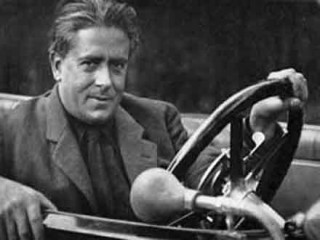
Francis Picabia biography
Date of birth : 1879-01-22
Date of death : 1953-11-30
Birthplace : Paris, France
Nationality : French
Category : Famous Figures
Last modified : 2011-05-05
Credited as : Artist writer, Dada,
Francis Picabia was a French artist, writer, and bon vivant who contributed to various art movements in the 20th century and became best known as a leader of Dada in Paris.
Francis Picabia viewed his art as an intimate extension of his life. It was a means to express his likes and dislikes, his thoughts and feelings—often without bothering to distinguish between those which were serious or trivial, public or private. That attitude made for enormous variety in the styles and quality of his work, and he insisted on such freedom of expression even when it meant that most of the public might not like or understand what he was doing.
Picabia was born in Paris on or about January 22, 1879. His mother was French and his father was a Spaniard living in Paris. Both parents came from wealthy, distinguished families, and Francis—their only child—was thoroughly spoiled, especially after his mother died when he was seven. He entered the School of Decorative Arts in 1895 and later studied with several teachers, including Felix Cormon. In 1902 he met the sons of the aged impressionist painter Camille Pissarro, who introduced him to their father. Picabia became an Impressionist and travelled extensively to record scenes of France in the relatively objective manner of that style.
By 1908 Picabia had become dissatisfied with Impressionism. He began to paint in more subjective and abstracted styles, particularly the styles of Fauvism and Cubism. He was encouraged by Gabrielle Buffet, a music student whom he married in 1909. They talked about developing "pure painting"—an art which did not imitate nature but could express profound meanings through form and color alone. They compared "pure painting" to music which did not imitate the sounds of nature but which stirred the souls of listeners by harmony and rhythm. At this time Picabia became an active member of the avant-garde in French art. He helped to finance and organize the important exhibition of the Section d'Or in 1912. The poet and art critic Guillaume Apollinaire named him as one of the artists creating "pure painting" or Orphism.
In 1913 Picabia and his wife visited New York to see the famous Armory Show which introduced modern European art to America. They became friends of the American photographer Alfred Stieglitz, who organized an exhibition of Picabia's work at his gallery, called 291. Two of Picabia's most renowned paintings, Udnie (1913) and Edtaonisl (1913), were huge, abstract compositions based on experiences during that trip to New York.
When World War I began in Europe, Picabia was drafted into the army. In 1915 he was sent on a supply mission to the Caribbean, but when his ship reached New York he neglected that mission in order to work again with Alfred Stieglitz. It was an important period during which Picabia began to write poetry and to develop a radically new style of painting based on curious machines. Most of the machines were symbolic of man and human activities, because Picabia believed that machines had become the touchstone of the modern world and that man had made machines in his own image. Many of the paintings also incorporated unusual titles and seemingly nonsensical inscriptions. Picabia was influenced in this new style by his French friend Marcel Duchamp, who also settled in New York in 1915.
Late in 1915 Picabia resumed his military mission. For two years he moved around from the Caribbean to Barcelona, Spain, to New York again. In late 1917 he left America permanently for Europe.
In 1919 Picabia met the Dadaists in Zurich who had been attracted by his unusual machine paintings and volumes of poetry bearing such titles as Platonic False Teeth and Poems and Drawings of the Daughter Born without a Mother. The leader of Zurich Dada, Tristan Tzara, moved to Paris in January 1920. A Dada movement began immediately under the leadership of Tzara, Picabia, and Andre Breton. Parisians were outraged by their deliberately offensive publications, exhibitions, and public activities. Picabia's painting, poetry, and magazine entitled 391 were considered anti-art and anti-literature. By mid-1921, the Dadaists in Paris were quarreling among themselves, and Picabia left the movement. A Dadaist irreverence continued to flavor his work, including his collaboration with Rene Clair in 1924 on the film Entr'acte. That film became the intermission for Picabia's ballet, Relache, produced in 1924 by the Swedish Ballet with music by Erik Satie.
In 1924 Picabia and his new wife, Germaine Everling, moved to Mougins on the French Riviera. There he lived the life of a playboy until the outbreak of World War II. He extended his reputation for numerous girl friends and fast automobiles. During the early 1930s, he began living on his yacht with Olga Mohler, who became his last wife in 1940.
Picabia continued to work prodigiously as a painter. From about 1924 to 1928 he produced collages and distorted figurative paintings later called "the Monsters." His next paintings, from 1928 into the early 1930s, were called "transparencies." They were characterized by multiple layers of transparent images—many drawn from sources in ancient and Renaissance art—which created poetic, dream-like effects. Later in the 1930s Picabia produced a variety of simplified figurative studies, superimposed images, and abstract compositions.
During World War II Picabia's life style became more modest. Most of his paintings presented sentimental subjects—nudes, toreadors, flower girls—derived from popular reproductions in postcards and cheap magazines.
After the war, in 1945, Picabia and Olga returned to Paris. His work flourished in a new round of abstract art. Many old friendships were renewed, and he published several volumes of poetry. He died in Paris on November 30, 1953.



















